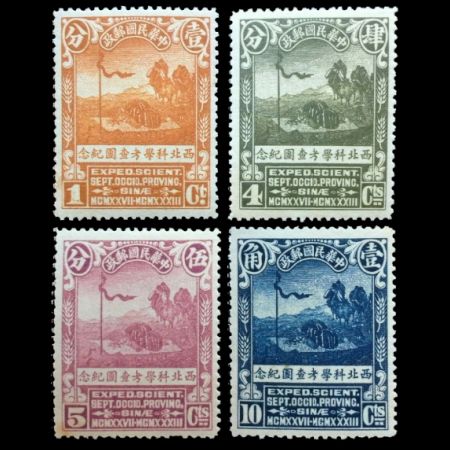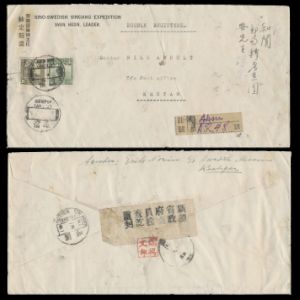| <<prev | back to index | next> |
China 1932 "Scientific Expedition to the Northwestern Province of China 1927–1933"
| Issue Date | 03.06.1932 |
| ID | Michel: 246-249, Scott: 307-310, Stanley Gibbons: , Yvert & Tellier: , Category: Ot. |
| Designer | |
| Stamps in set | 4 |
| Value |
1c - Nomads in the Desert - orange 4c - Nomads in the Desert - olive 5c - Nomads in the Desert - lilac pink 10c - Nomads in the Desert - blue |
| Type | commemorative |
| Size (width x height) | 35mm x 45mm |
| Layout | Sheets of 25 stamps |
| Products | |
| Paper | |
| Perforation | 14x14 |
| Print Technique | Intaglio |
| Printed by | Government Printing Office, Peking (Beijing) |
| Quantity | 25.000 stamp sets |
| Issuing Authority |

In 1932, China released a set of four stamps with the topic "Scientific Expedition to the Northwestern Province of China 1927–1933".
The four stamps (same design, but different colors and face values) show camels at a camp with the expedition flag and bear the Chinese text, "Postal Service of the Prosperous Middle Kingdom" and in Latin underneath, "Scientific Expedition to the Northwestern Province of China 1927–1933".
A painting in the Peking (now Beijing) Palace Museum entitled Nomads in the Desert served as the model for the series.
Of the 25,000 sets, 4,500 were sold over the counter and 20,500 came into the possession of the expedition. Dr. Sven Hedin, the leader of the expedition, used them to finance the expedition, selling them for a price of 5 dollars per set. The stamps were not popular at the time due to the high price Hedin was selling them at, but years later became valuable treasures among collectors.
 |
| Sven Hedin on stamp of Sweden 1973, MiNr.: 814, Scott: 1009 |
Sven Hedin (19 February 1865 – 26 November 1952) was a Swedish geographer, topographer, explorer, photographer, travel writer and illustrator of his own works.
The Sino-Swedish Expedition was a bilateral Chinese-Swedish expedition, led by Sven Hedin, which carried out scientific research in north and northwest China, 1927–1935. The Sino-Swedish expedition (SSE), was a major scientific joint undertaking of Republican China (1912–1949) and Sweden.
The Expedition looked in particular at the meteorology, topography and prehistory in Mongolia, the Gobi Desert and Xinjiang.
- 1927–32 – from Beijing – via Baotou, Mongolia, the Gobi Desert, Xinjiang – to Urumqi
- 1933–34 – from Beijing to Kashgar, with a view to constructing two roads suitable for cars
The first part of the expedition, from 1927 to 1932, led from Beijing via Baotou to Mongolia, over the Gobi Desert, through Xinjiang to Urumqi, and into the northern and eastern parts of the Tarim Basin. The expedition had a wealth of scientific results which are being published up to the present time. For example, the discovery of specific deposits of iron, manganese, oil, coal and gold reserves was of great economic relevance for China.
It was the first scientific collaboration between China and Europe of its kind and scale. According to the agreement on the joint research program, paleontological, paleobotanical, and archaeological items found in the field would be examined in Europe before their return to China, a promise that was fulfilled in the 1950s.
The expedition has had a significant influence on the development of science in China because the students who joined the expedition later occupied high positions in the Chinese scientific community. The results have been published in 56 volumes in the series Reports from the Scientific Expedition to the Northwestern Provinces of China, under the Leadership of Dr. Sven Hedin—The Sino-Swedish Expedition.
Although the expedition was primarily based on other disciplines, there were also many important discoveries in the field of paleontology.
For example, one key discovery was the finding and naming of Tienshanosaurus. Moreover, additional fossils that were discovered during this expedition provided important information that would prove valuable for the research of Chinese vertebrate paleontology in the future.
Anders Birger Bohlin (March 26, 1898 in Lidköping – November 28, 1990 in Uppsala),
was a Swedish paleontologist and paleobotanist.
In 1929 Bohlin took part in the expedition as a paleontologist until 1933 and collected many fossil vertebrates.
Among his most famous discoveries were the mammalian faunas from the late Oligocene at the Taben-buluk
paleontological site in western Gansu.
Bohlin also made important collections of Cretaceous reptiles and Carboniferous plants.
In the introduction of "Report from the Scientific Expedition to the North-Westen Province of China
under leadership of Dr. Sven Hedin", published in Stockhold, Sweden in 1953, Bohlin made an overview
about paleontological discoveries of the expedition.
Of the 54 landscape-format monographs published as reports of the scientific expeditions to the north-western
provinces of China led by Sven Hedin, Bohlin wrote 13 parts, including two voluminous monographs on
Taben-buluk faunas, one on Cretaceous reptiles and one on Carboniferous plants.
Bohlin also wrote several monographs on Chinese fossil vertebrate fauna in the Palaeontologia Sinica
journal series, as well as a number of shorter articles on Chinese vertebrate fossils.
 |
| A Letter to Dr. Anders Birger Bohlin, sent from Stockhold to Peking in 1929. |
One of such dinosaurs was named Peishansaurus by Bohlin in 1953.
Its fossils were discovered in 1930 at Ehr-chia-wu-t'ung, in the west of Gansu, in a layer of the Minhe Formation dating from the Campanian. One of the fossils consists of a 5-centimeter long piece of a right lower jaw with 4 empty tooth sockets and one loose tooth. Peishansaurus was a genus of ornithischian dinosaur that lived during the Late Cretaceous period, roughly 85-72 million years ago.
Bohlin placed it in the Ankylosauridae, assuming the fossil represented a juvenile ankylosaurid, but it could also be a pachycephalosaur.
Further there are some turtles, the Mesozoic ones representing five genera. Of remains of other archosaurs there are only two tooth fragments of crocodiles. As most of the material is too scanty to contribute much to the general knowledge of the larger groups to which it belongs it has been thought preferable to treat the remains from the different localities separately.
The work has been carried out at the paleontological institution at Uppsala in Sweden where everything possible was made to facilitate it.
Some other paleontological discoveries were made by Professor Yuan Fu Li of Tsinghua University, China.
Professor Yuan Fuli (1893—1987), a famous geologist, geographist and archaeologist of China, learned in USA in early 1900’s.
He was the director of the department of Geosciences of Tsinghua University from 1933 to 1952.
Professor Fili participated and organized Sino-Swedish Scientific Expedition in the Northwestern Provinces of China and discovered
plenty of animal and plant fossils during the field inverstigations, particularly in discovering
Dicynodon sp. and Lystrosaurus sp.
in Xingjiang Autonomous Region, by means of which possess with significance in development of
geosciences in China.
 |
| Mamenchisaurus on stamp of China 2017, MiNr.: 4900, Scott: 4445 |
On September 1928, he discovered very well-developed red beds, 10km to the south of San-t'ai, were he found fragments of a metatarsus belonging to a dinosaur.
He continued his excavations, in the different places of the valely, for forty days.
During this time he found fragments of thirty full-grown dinosaur individuals, three young ones, as well as a some dinosaur eggs.
The finds, including a fossilized egg, were sent to Beijing where they ultimately became part of the collection of the Institute of Vertebrate Paleontology and Paleoanthropology.
In 1937 paleontologist Yang Zhongjian ("C.C. Young"), who also described and named Lufengosaurus, named the type species Tienshanosaurus chitaiensis The generic name, refers to the Tian Shan, the "heavenly mountains". The specific name refers to the location Chitai or Qitai.
Tienshanosaurus chitaiensis is an extinct genus of sauropod dinosaur, from Mamenchisauridae family, from the Late Jurassic.
Its body length has been estimated at 12 meters, 2.8 meters high and 4.4 tones of weight.
Tienshanosaurus chitaiensis was not only the first sauropod discovered in China, but also the first Jurassic sauropod discovered in entire easter Asia.
According to the agreement with the Chinese authorities some fossils were repatriated in the early 1950s, and allegedly also during the period of the Cultural Revolution, and today at least the early consignments are found in the Museum of Paleontology in Beijing. Parts of the collections are, however, still found in Sweden, where these collections were allowed to remain; today with the Museum of Natural History, Stockholm.
| FDC (registered letter sent on the first day of issue) |
Signed, by Sven Hedin, stamps | Used cover |
 |
 |
 |
| A Letter from the Expedition | A Letter to the Expedition | A Letter to Sven Hedin |
 |
 |
 |
References:
- [R1] Technical details and stamps presentation: Linns Stamp News,
-
[R2] Sino-Expedition:
Wikipedia,
Sven Hedin Foundation,
China Connect University,
.
"Report from the Scientific Expedition to the North-wESTEN Province of China under leadership of Dr. Sven Hedin", by Birger Bohlin, Stockholm 1953 Professor Yuan's Discoveries (History of the Expedition in Asia, 1927-1935 : vol.2), - [R3] Sven Hedin: Wikipedia, Encyclopedia Britannica, Sven Hedin Foundation, encyclopedia,
-
[R4] Anders Birger Bohlin:
Wikipedia (in German)
- Peishansaurus: Wikipedia
-
[R5] Yuan Fuli:
Nature.shu
- Tienshanosaurus: Wikipedia, biologie-seite.de (in German), "Encyclopedia of Dinosaurs: The Sauropods", by Rubén Molina-Pérez and Asier Larramendi. Published in 2020, ISBN-13: 978-0565095185.
| <<prev | back to index | next> |